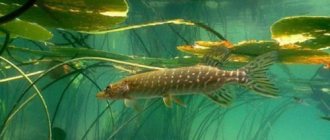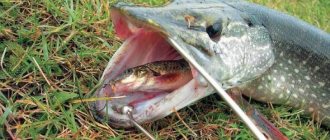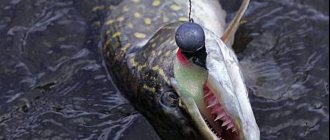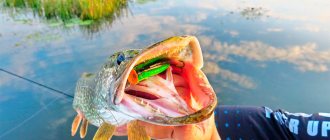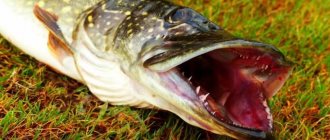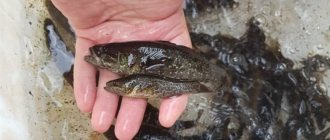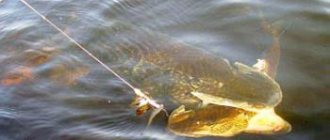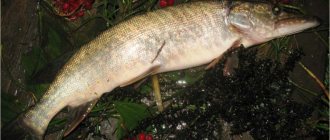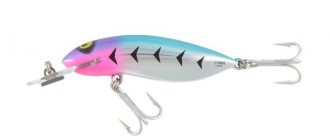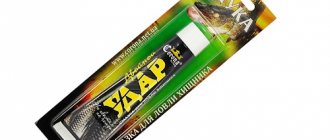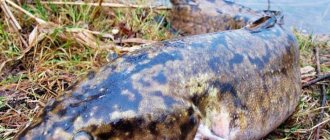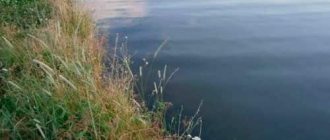Yuri 09/11/2020 533
In spring, the water begins to warm up, and small fish move to shallow bays. In such places, aquatic vegetation predominates, where the fry feed and take shelter from the summer heat, followed by the formidable predator - the pike. In such places you rarely see a large specimen, but a small herb pleases with its quantity and desire to feast on a flock of fry. How and what to catch it with - more on that later.
Choosing the right time
Fishing for pike in shallow water comes with its own peculiarities. At night and in the morning, the fry stays at a depth of about 1 m - shallow areas are still cool. Therefore, in the morning you should fish these particular areas. Rapid warming of coastal areas begins at sunrise in windless, partly cloudy weather. And at this time we gradually move to coastal areas with grassy thickets. In the evening we monitor the temperature in the opposite direction - the water cools down, the fry goes into small holes.
At what time of year do you catch pike with a spinning rod?
When and where to catch pike? The second half of spring and June are considered one of the most favorable periods. Pike spawns early (sometimes before the ice begins to melt), and already about 7-10 days after the end of spawning, during which the fish are “sick,” the intense biting season begins.
On hot summer days, the best time for fishing for pike is considered to be early morning and late evening, but in cool rainy or cloudy weather the fish bite well throughout the whole day. At the same time, pike fishing with a spinning rod is carried out mainly in shallow water, near the coastal zone.
Often intense biting is observed in thickets of perennial aquatic plants and water lilies. Fishing with a spinning rod for pike in the fall has some peculiarities. After the reservoirs cool down, the fish traditionally move to deep water. At the same time, a good pike bite in the fall is also possible in fairly shallow areas of lakes and rivers - this picture is mainly observed in large bodies of water with thick algae and the absence of a large number of small fish.
Many fishermen successfully catch pike with spinning rods in October and November before freeze-up, however, mainly on those days when there is sunny, clear weather with an increasing temperature.
Selecting tackle and bait
Here we don’t need a long spinning rod, but less than 2.4 m will not work. The spinning rod should have an average length of 2.7 m, so that it is convenient to guide the bait along the corridors among the vegetation.
The reel is inertialess, size 2500-3000. To catch pike, it is better to choose a power reel, since we will not use fast wiring. Monofilament line or braid. If we fish short distances, we choose monofilament line. Catching pike in shallow water with wobblers requires an average working depth - floating baits or suspenders. The wiring horizon is 30 cm from the water surface. There is less vegetation here, and for pike the bait is clearly visible from daylight.
In addition to wobblers, the Minnow Spoon spinner works great. The shape and hidden hooks do not allow it to cling to thick grass, and the game is maintained throughout the retrieve.
Croatian egg bait
If we are fishing in shallow water with dense vegetation, where even a popper cannot avoid the thickets, the “Croatian egg” bait will come to the rescue. It has a recessed bow area and a floating game, the hook rises above the surface of the water. The bottom of the bait slides through the grass, but the hook remains on top and does not catch anything.
This bait is famous for its spectacular bite, which can be observed in detail from the shore. At the same time, its effectiveness, compared to other baits, is lower, since the pike may not smooth out the hook the first time.
Correct loading for shallow depths
When preparing a match fishing rod for working in shallow water, beginners often experience difficulties precisely when distributing loads on the central line. The float, which has only a single attachment point, sometimes rotates quite freely around the line. This can create significant problems if an olive gets caught in the rotation. In this case, the equipment will get tangled around the waggler antenna.
To avoid such a situation, shallow-water gear is loaded as follows: the maximum weight falls on the float, the minimum load is distributed over the sub-float. Its small mass, combined with the windage of the line, makes it possible to avoid rotational movements around the unstable waggler.
The equipment is simple:
- One small weight is attached to the central line, which is enough to pull the bait to a depth of a meter and a half; its rise by the fish is recorded by a pop-up antenna.
- The sinker is located at one point, directly next to the swivel.
- When reeling in quickly, the line may become twisted; to partially avoid this, it is necessary to increase the section of the leash.
It is important to know that if the leash has become intertwined at least once, it will behave the same way in the future, so it must be changed immediately.
Drowning scaffolding technique
When casting with match gear in shallow water, in order not to frighten the fish spinning around the bait, you need to throw the fishing area and then sharply pull the waggler. The throw is made several meters, while pulling up the fishing line is retracted at the same time. We described the simplest option in the article “How much does match fishing equipment affect casting.”
Having lowered the tip of the fishing rod into the water, we make a sharp reeling of the reel. On one side the fishing line is sunk with a waggler, on the other - with the tip of the rod. By rewinding, the force of surface tension is overcome, and the entire line goes under water. At short distances, this method is impractical, since sometimes you have to move a lot to cut through the film of water.
To speed up the sinking of the line, you need to make jerking movements with the tip of the rod a couple of times, after each jerk, picking up the slack of the monofilament. There is one drawback - match fishing in shallow water, when the float often hits the ground, so it is recommended to significantly move the fishing point.
Features of fishing for pike in shallow water
- We lead the bait near the thickets. Windows among the vegetation in the summer heat are the only option to catch grass.
- Availability of disguise. Pike parking areas can be located under the shore - literally two meters away. As soon as the angler approaches the shore, the pike immediately becomes alert and may leave the parking area. We begin to fish nearby areas, standing behind cover and not approaching the edge of the shore.
- We take several types of bait with us. Pike are not averse to eating a good suspended wobbler. But already the first cast can bring a hooked tuft of grass. The lightweight spinner also works great for pike and is less likely to get caught on grass and snags.
- If there are no bites after three trips, we change the bait or fishing location. In some cases, the predator may simply be inactive or the bait may not be within the predator's field of vision.
Fishing for pike in shallow water in the grass gives good results with silicone bait. If you have tried several types of wobblers, vibrating tails, twisters and spinners, fished several different places, but still no bites, most likely the problem lies in the lack of activity of the predator. In this case, it is better to know when the pike is most active and follow the “Fisherman’s Calendar”.
TAGS:
Shallow water carp fishing time
The most successful time for catching carp in shallow water is May, the period from mid-July to mid-August. We are talking, first of all, about closed reservoirs: lakes, rates, paid reservoirs. The best places for summer carp fishing in shallow water are located in the shade of trees. In May, it is better to fish in the warmest places, where there is the most food at this time.
It should be taken into account that the carp bite in small water areas is short-lived. He bites here for several hours, depending on the weather. If the weather is hot, the bite will be after sunrise for 2-3 hours.
In cloudy and rainy weather the bite is usually weak. He recovers with clarity. On days like these, when the weather begins to improve, it is good to catch carp in the afternoon and until the evening.
It is very important to know the habits of the burl in a particular place. In small water areas there are always places where trophy specimens are well caught close to the shore. The most important thing is to determine the carp feeding hours at the fishing site.
Some experienced anglers who have studied the reservoir well fish for 3-4 hours, when the carp are most active. The fisherman's task is to wait for the bite. Patience and durability of the tackle come to the fore here.
Carp feeding hours depend on the time of year, air and water temperatures, as well as the time of day. On one reservoir, carp feed only in the afternoon, and on the second - only in the morning or evening. On paid sites, the timing of carp feeding is of great importance. After bringing a large amount of food to the point, the carp eat as much as possible and refuse to bite for several days.
On many paid reservoirs, feeding hours are set by the owners. This point should definitely be taken into account. It is useful to know exactly what hours carp bite most actively, so that you can come fishing several hours before this moment. During this time, you can settle in place and do the starting feeding.
The feeding time of carp directly depends on the water temperature and wind direction, as well as pressure. Interestingly, with a sudden change in weather, you can expect both a lack of bite and a glutton of fish. For example, if a lot of rain falls in a few hours, this can lead to an increase in the number of bites. The oxygen balance improves and the carp become active.
When it gets hot, carp feed less and less in shallow water areas, going deeper.
[custom_ads_shortcode1]
Tags
Carp Buffalo Spring Vobla Asp Winter Crucian Rudd Summer Fishing baits Lower Volga Perch Autumn Fisherman's reminder Lures Bite forecast Fishing in Astrakhan Fishing baits Fishing tackle Fishing secrets Catfish Fishing methods Pike perch Catch Pike
Equipment of the vents
Ideally, the line reserve on the reel should be at least 18–20 m. In this case, biting, swallowing live bait, unwinding the line and fishing should take place according to the most favorable scenario. But in practice, when fishing in the coastal zone, the fisherman is forced to limit himself to 12–15 m of fishing line. This reserve is quite enough for successful fishing. But in shallow water there are also plenty of snags.
Knowing the location of numerous obstacles in the fishing area, the fisherman is forced to reduce the length of the fishing line to 7–8 m, and in some cases even 5 m. As practice shows, this supply of fishing line is quite enough not to be left without a catch, since an extra meter of fishing line sometimes leads to a fatal snag.
Many reputable bait fishermen from the Baltic States, Karelia, Arkhangelsk and Pskov regions are convinced that the maximum supply of fishing line on a winter bait should not exceed 10 m and that only in this case the pike is detected for sure. Naturally, the fishing line diameter of our northern colleagues is rarely less than 0.6–0.8 mm. Let’s say right away that when fishing in shallow water, our fishermen usually use a main line with a diameter of 0.35–0.4 mm, since the probability of a break when fishing for pike from a depth of 10–15 cm with half a meter of ice thickness is quite high. The size of the treble hook or single hook is set depending on the size of the baitfish.
Pike in shallow water in grass and reeds
The reeds can be examined both from the shore and from a boat. From the edge of the shore to the edge of the thickets there are usually small corridors, which are subject to exploration with a spinning rod.
If the pike is not active, then you should spend at least 30 minutes to achieve results. When the depth allows you to reach the edge of the reeds, it is recommended to continue fishing, casting along the edge.
Fishing from a boat gives you more opportunities
Here the focus is on remote wilderness areas. This can be not only coastal reeds, but also islands located at some distance from the coast.
Despite the large number of attractive places, such as capes and creeks, you should carefully examine every meter, making many casts.
With passive behavior, the predator does not rush at the prey, but can watch it for a long time.
If there are sunken trees or large stones, special attention is also paid to them, since the pike can hide behind them.
Shallow water. Pike fishing
Quite often, pike look for prey in shallow water areas, hiding in dense vegetation or finding shelter for ambush in snags. Under the cover of natural objects, the toothy predator waits for the appearance of small fish, which it immediately attacks. In such places you can often hear splashes or see pike chasing. There have been cases when a fish attack occurred right near the shore. Therefore, the statement that it is impossible to catch a large trophy in small places is erroneous. Due to this behavior of pike, anglers often try their luck in shallow water. In shallow conditions, they use spinning rods, fishing rods or special mugs designed for catching toothy fish in shallow places.
What are these areas of the reservoir? As a rule, these are shallow areas with a water depth of up to one meter, but there must be aquatic vegetation nearby. Either it is reeds, or maybe islands of algae or a dense strip of plants located not far from the shore. Areas of the reservoir with an abundance of snags are also considered successful for pike fishing. In a word, if there are shelters in shallow areas where a toothy fish can ambush fish, then such places are quite suitable for an angler to start fishing for a predator.
Read: Fishing for pike on a balance beam in winter
Fishing gear is selected that is strong, be it a spinning rod or a float rod for fishing with live bait. The fishing line is also chosen to be strong and thick, and you can also equip the rod with a braided cord. It’s worth mentioning separately about the leash. It must be metal. This is typical for catching predators, especially pike. While playing, the fish desperately resists, spins, freezes in place, and wraps grass around itself. But that's not all. Pike have particularly sharp teeth that can grind a simple fishing line.
The bait for catching pike is selected depending on the fishing conditions. Not only the individual reservoir, weather conditions and preferences of the fish, but also what kind of wiring you will do and near what local objects. For example, if you are moving the bait along the edge of clear water and a strip of dense aquatic vegetation, then you will have to choose from a diverse line of spinners designed for this. If you conduct wiring over aquatic vegetation, which does not come to the surface of the water, but grows lower, in the water column. For this you should use poppers or wobblers for fishing in the upper waters.
Read: Twitching pike. An interesting way to catch toothy fish
When fishing in shallow water, the fishing line should be kept taut at all times so as not to miss a pike bite and to quickly react and hook. As soon as you feel that the trophy is securely on the hook, begin a leisurely, methodical fishing for the predator. And here you have to not only demonstrate your calmness and not succumb to the impulse of joy, which can harm the successful completion of the event. But also quickly apply your knowledge of fishing. Where you need to loosen the line a little, and when necessary, on the contrary, quickly wind it onto the reel. If you just forcefully pull the trophy towards the shore, then large pikes can get away, breaking the rod, breaking the line, fraying the leash, or tangling the tackle so much that you have to cut the line.
Happy pike hunting in shallow waters!
Tackle and bait for catching pike in shallow water
The spinning rod for this type of fishing should be light or ultra-light. Its length should be longer than average size. This allows you to make precise casts while working for several hours at a time.
Spinning reels with a small winding section are well suited for short casts. It is recommended to carry a spare spool equipped with braided fishing line - braided fishing line allows you to get out of even the most difficult snags on grass or snags.
Since the fishing is not for very large fish, the fishing line is taken with a size of 0.15 mm in diameter. A metal leash is required. Otherwise, every bite may result in the loss of bait.
Silicone vibrating tails have recently become the most popular. For fishing in reeds, baits are made of hard but elastic rubber. Their color can be different, it is greatly influenced by the weather and the place of fishing - the color needs to be selected.
Also used in thickets are models of non-hooking wobblers and poppers floating on the surface. Various models of rotating spinners and oscillating non-hooking spoons will always be relevant.
Catching pike in the reeds - short video clips:
Fishing for pike in shallow water in summer
2.1k Views
In summer, the reeds abound with all kinds of living creatures, for example, the larvae of various insects, which attracts a large number of small fish. And where there are small fish, there is a predator. Very large specimens, of course, will not be caught in shallow water, but medium-sized pike are guaranteed to be found there.
In addition to excellent camouflage, reeds are also a resting place for predators. Therefore, luring fish out of the reeds is quite simple, especially during the period of its activity. And since pike is constancy, there may be several specimens in one area.
